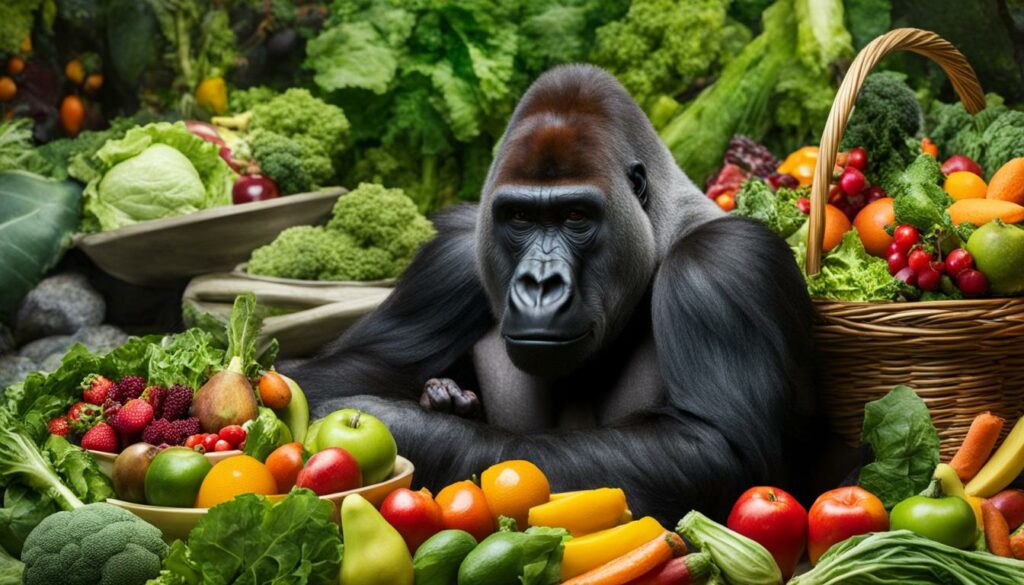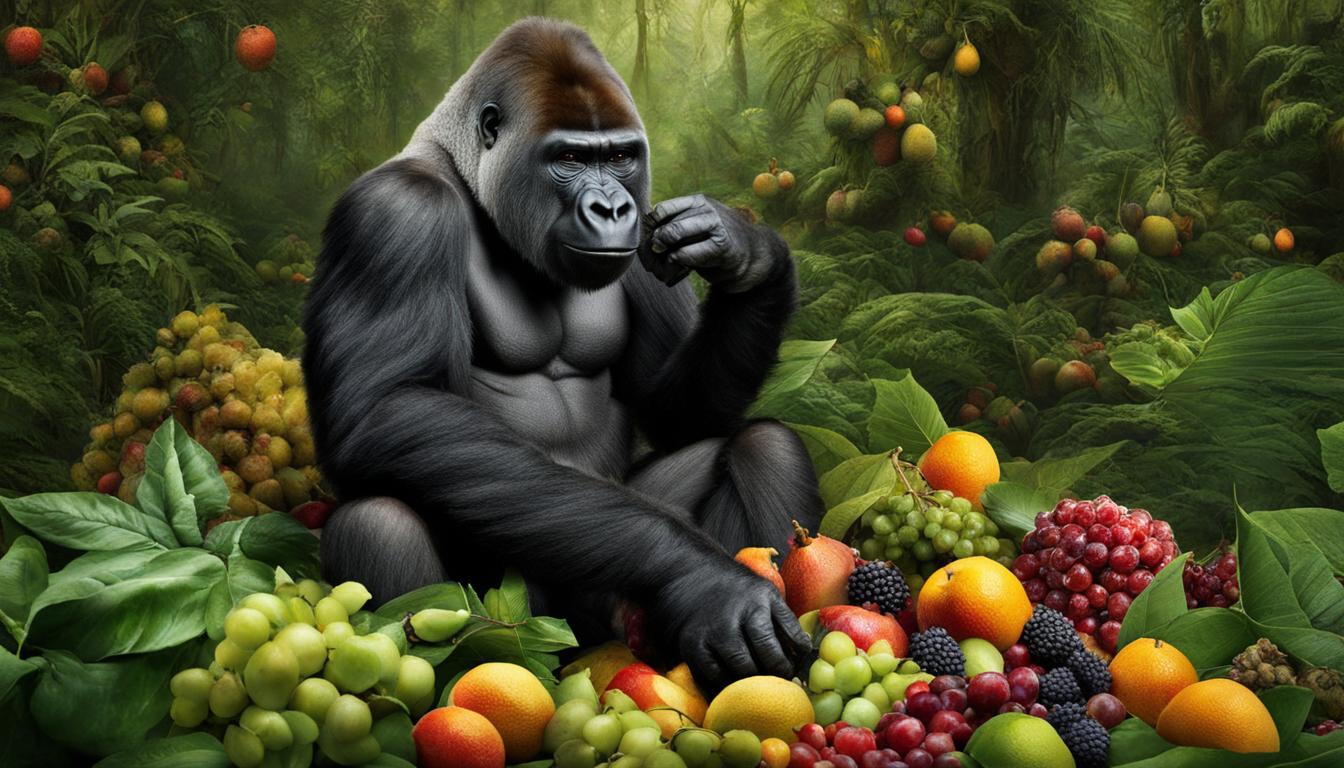Gorillas are known for their vegetarian diet, consuming a wide variety of plant-based foods. Their diet consists of leaves, stems, shoots, and fruits, among other plant materials.
But what exactly do gorillas eat, and what are their food preferences?
In this article, we will explore the natural diet of gorillas, their feeding habits, and the nutritional aspects of their menu. So, if you’ve ever wondered what gorillas eat or are curious about their vegetarian diet, you’ve come to the right place.
Stay tuned to learn more about the gorilla’s food preferences and discover the fascinating world of gorilla nutrition!
Gorilla Foraging Habits
Gorillas have fascinating foraging habits that contribute to their unique feeding behavior. They possess a remarkable ability to selectively choose specific parts of vegetation to consume, utilizing their agile lips and dexterous hands to manipulate the plants. Their exceptional strength allows them to break apart vegetation, such as shredding a whole banana tree. This selective foraging ensures that gorillas do not overexploit an area for food and allows for the quick replenishment of crop vegetation.
Gorillas are also known for their surprising use of tools during foraging. They have been observed using their hand hair to absorb water from various sources, such as leaves or branches, and then sucking the water. This ingenious behavior showcases the resourcefulness and adaptability of these incredible primates.
Furthermore, gorillas demonstrate a cautious approach to food gathering. They are careful not to consume toxic or harmful plants by relying on their sense of smell to detect foreign odors. This finely attuned sense of smell helps them identify edible foods and avoid potential dangers in their dense jungle habitats. Additionally, their deft hands aid in handling food, tearing apart branches, and manipulating vegetation to extract the desired portion.
Gorilla Food Selection
Gorillas exhibit specific preferences when it comes to plant selection for their diet. They consume a wide variety of vegetation, including leaves, stems, roots, vines, herbs, trees, and grasses. Gorillas have been observed favoring certain parts of plants, such as leaves, pith, stalks, or roots. This selective feeding behavior indicates their ability to distinguish between different plant parts based on nutritional content or taste.
“Gorillas have the incredible strength to break apart vegetation, like shredding a whole banana tree.”
While gorillas primarily rely on plant materials for sustenance, they may also consume small amounts of insects, termites, ants, or grubs. This additional protein source supplements their primarily vegetarian diet and helps meet their nutritional needs. Overall, gorillas’ foraging habits and food selection contribute significantly to their overall health and survival in their natural habitats.
Gorilla Senses and Food Finding
Gorillas rely on their senses to navigate their environment and locate food. Their keen senses of vision, smell, touch, and hearing play crucial roles in their daily foraging activities.
Gorilla Vision
Gorillas have well-developed vision, enabling them to detect and distinguish colors. Their eyesight helps them identify ripe plants while foraging. Additionally, their binocular vision provides them with depth perception, allowing them to accurately judge distances and navigate their surroundings.
Gorilla Smell, Taste, and Touch
Gorillas have a highly developed sense of smell, which they use to detect odors and identify edible foods. This sense allows them to locate ripe fruits and other vegetation. They also rely on their sense of taste to assess the quality and palatability of food. Gorillas are known to use their sensitive fingertips to explore and manipulate their food, allowing them to identify the best parts of plants to consume.
Gorilla Hearing
While hearing is not primarily used to find food, gorillas rely on their sense of hearing to detect potential threats in their dense jungle habitats. Their acute hearing helps them remain alert and aware of their surroundings, ensuring their safety while foraging.
| Senses | Role in Food Finding |
|---|---|
| Vision | Helps gorillas identify ripe plants and navigate their environment. |
| Smell | Enables gorillas to detect odors and identify edible foods. |
| Taste | Assesses the quality and palatability of food. |
| Touch | Allows gorillas to explore and manipulate their food, identifying the best parts to consume. |
| Hearing | Helps gorillas remain alert and aware of potential threats while foraging. |
The combination of these senses enables gorillas to successfully find and select the most suitable vegetation for their dietary needs. By utilizing their vision, smell, taste, touch, and hearing, gorillas ensure their survival in their natural habitats.
Gorilla Diet and Range
The diet of gorillas varies depending on the plants available in their habitat and changes with the seasons. The different subspecies of gorillas have specific food preferences and forage for a variety of plant materials, including leaves, stems, shoots, fruits, and seeds. They may also consume small amounts of animals such as insects, rodents, and small invertebrates. Gorillas have been observed eating around 200 different types of plants.
The availability of food also influences the gorilla diet. Western gorillas, for example, consume a diet that is high in fiber and mostly consists of seasonal foods. Fruits make up a larger portion of their diet. Eastern gorillas, on the other hand, primarily eat foliage, with fruit making up a smaller percentage of their diet. Gorillas are known to selectively forage for specific parts of vegetation, such as leaves, pith, stalks, or roots. They have the ability to manipulate vegetation using their agile lips and hand dexterity to consume the portion they want.
The range of a gorilla group typically spans between 1 and 6 square miles. Gorillas do not forage for food over large distances, with their foraging trips generally not exceeding 1.5 miles. This limited range allows them to efficiently find food while minimizing unnecessary energy expenditure. However, food competition can arise among gorilla groups within the same range, particularly when resources are scarce. Gorillas have adapted to their environments by developing specific dietary preferences, foraging habits, and range behaviors to ensure their survival and well-being.
Diet Variation Among Gorilla Subspecies
Table: Gorilla Diet Variation Among Subspecies
| Subspecies | Main Components of Diet |
|---|---|
| Western Gorilla | Fruits, leaves, seeds, termites, caterpillars |
| Eastern Gorilla | Foliage, leaves, shoots |
| Mountain Gorilla | Leaves, shoots, stems, roots, flowers, fruit, insects |
| Cross River Gorilla | Fruit, leaves, stems, piths, invertebrates |
Gorilla Diet in Captivity
In captivity, the diet of gorillas is carefully managed to ensure their health and well-being. Although their natural diet consists of a variety of plant materials and insects, captive gorillas are typically provided with a more frugivorous diet, meaning they consume a higher percentage of fruits. They are given up to six meals a day, including fruits such as bananas, berries, and apples, which are readily available in zoos.
Additionally, captive gorillas have access to a range of foliage, which helps to mimic their natural feeding habits. This includes leaves, stems, and shoots from various plant species. While some zoos may provide processed cereals as occasional treats, these are not a regular part of their diet as they do not reflect their natural food preferences.
Gorillas in captivity rarely have access to insects like they would in the wild. However, some zoos may include grubs and larvae as alternative protein sources to ensure their nutritional needs are met. Overall, the diet of captive gorillas is carefully balanced to provide them with the necessary nutrients while also considering their natural food preferences.
| Food | Percentage of Diet |
|---|---|
| Fruits | 60% |
| Foliage | 35% |
| Oats and cereals (occasional treats) | 5% |

Gorilla Diet throughout Life Stages
As gorillas progress through different life stages, their dietary needs and preferences evolve. The diet of baby gorillas primarily consists of their mother’s milk, which provides essential nutrients and helps with their growth and development. This period of milk dependency typically lasts for around 2.5 to 3 years. As they mature, baby gorillas gradually transition to the same plant-based diet as adult gorillas.
While milk forms a significant part of a baby gorilla’s diet, infant gorillas may also consume small quantities of insects, such as ants and termites. These additional sources of protein help supplement their nutritional intake and aid in their overall development.
Once gorillas reach adulthood, their diet expands to include a variety of plant materials. Adult gorillas consume leaves, stems, shoots, and fruits from a wide range of plant species. They may also occasionally consume small amounts of animals, such as insects, rodents, and small invertebrates. This comprehensive diet ensures that adult gorillas receive the necessary nutrients to thrive in their natural habitats.
Gorilla Diet throughout Life Stages
| Life Stage | Diet |
|---|---|
| Baby Gorillas | Mother’s milk, small quantities of insects |
| Adult Gorillas | Leaves, stems, shoots, fruits, occasionally small animals |
Conclusion
Gorillas have a primarily plant-based diet, consuming a variety of leaves, stems, shoots, fruits, and other plant materials. Their diet varies by subspecies, habitat, and season. Gorillas rely on their senses and physical abilities to find and consume food. In captivity, their diet may include more fruits and foliage, with limited access to insects. Overall, gorillas have specific dietary preferences and foraging habits that contribute to their survival and well-being.
Gorillas exhibit selective foraging habits, utilizing their agile lips and dexterous hands to manipulate vegetation and consume specific parts of plants. Their incredible strength allows them to break apart vegetation, enabling them to access their desired food portions. Despite their strength, gorillas do not overexploit areas for food, ensuring that vegetation has time to regenerate. They have also been observed using their hand hair to absorb water, showcasing their resourcefulness in obtaining hydration.
When it comes to finding food, gorillas rely on their sense of sight and smell. Their eyes’ ability to see in color helps them identify ripe plants, while binocular vision aids in depth perception. Their finely attuned sense of smell allows them to detect foreign odors, ensuring they choose safe and edible foods. While hearing is not directly used to locate food, gorillas rely on it to detect potential threats in their dense jungle habitats. Their deft hands play a crucial role in handling and manipulating food during feeding.
What role does diet play in the behavior and lifestyle of gorillas?
Gorillas have a primarily herbivorous diet, consisting of leaves, stems, and fruits. Interestingly, gorillas consume an average of 40 pounds of food daily. Their plant-based diet influences their behavior and lifestyle, as it requires them to spend much of their day foraging and eating to meet their nutritional needs.
FAQ
What do gorillas typically eat?
Gorillas have a primarily plant-based diet, consuming a variety of leaves, stems, shoots, fruits, and other plant materials.
What is the gorilla diet like?
The diet of gorillas varies by subspecies and includes vegetation such as leaves, stems, roots, vines, herbs, trees, and grasses. They consume a large quantity of low-nutritional vegetation.
Are gorillas vegetarian?
Yes, gorillas are herbivores and primarily eat plants.
What are gorilla feeding habits like?
Gorillas have selective foraging habits and eat specific parts of vegetation, such as leaves, pith, stalks, or roots. They use their agile lips and hand dexterity to manipulate the vegetation for the portion they want to consume.
How do gorillas find food?
Gorillas rely on their sense of sight and smell to find and identify edible foods. Their eyes can see in color, helping them detect ripe plants. They also possess binocular vision, which helps with depth perception. Gorillas have a finely attuned sense of smell to detect foreign odors.
What is the range of a gorilla group?
The range of a gorilla group is between 1 and 6 square miles, with foraging distances typically not exceeding 1.5 miles.
What do captive gorillas eat?
Captive gorillas have a more frugivorous diet compared to their wild counterparts. They are fed up to six times a day, consuming fruits like bananas, berries, and apples. They also have access to a variety of foliage.
How long do baby gorillas rely on their mother’s milk?
Baby gorillas subsist on their mother’s milk for around 2.5 to 3 years before transitioning to the same diet as adult gorillas.






